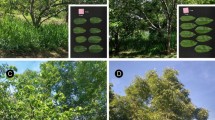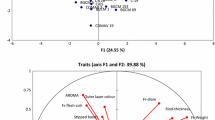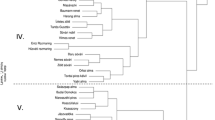Abstract
Malus sylvestris (L.) Mill. is the only indigenous wild apple species in Europe and recognized as rare and endangered species. An important prerequisite for the preservation of M. sylvestris is the identification of ‘true type’ M. sylvestris individuals because hybrids with cultivated apple could be also occurred. In this study variations among 625 putative M. sylvestris trees originated in the East Ore Mountains were evaluated with 20 selected morphological traits. The importance of these traits concerning the differentiation of ‘true type’ and hybrids of M. sylvestris were determined by statistical analysis. The results demonstrated a strong correlation of individual traits and those contributing mostly to variation of M. sylvestris were detected by the Principal Component Analysis. The relationship of 284 M. sylvestris, 18 M. × domestica, M. floribunda 821 and M. robusta 5 individuals were calculated based on the morphological data and presented in a dendrogram. The individuals grouped in two main clusters and 68 hybrids of M. sylvestris were identified. The main result of the morphological data of these hybrids indicates that the grouping is mainly based on the flower and leaf pubescence and less on the fruit size.




Similar content being viewed by others
Abbreviations
- PCA:
-
Principal component analysis
- ECPGR:
-
European cooperative program for plant genetic resources
References
Allendorf FW, Leary RF, Spruell P, Wenburg JK (2001) The problems with hybrids: setting conservation guidelines. Trends Ecol Evol 16:613–622
Asma BM, Ozturk K (2005) Analysis of morphological, pomological and yield characteristics of some apricot germplasm in Turkey. Genet Resour Crop Evol 52:305–313
Broothaerts W (2003) New findings in apple S-genotype analysis resolve previous confusion and request the re-numbering of some S-alleles. Theor Appl Genet 106:703–714
Castiglione S, Cicatelli A, Lupi R, Patrignani G, Fossati T, Brundu G, Sabatti M, van Loo M, Lexer C (2010) Genetic structure and introgression in riparian populations of Populus alba L. Plant Biosyst 144:656–668
Chezhian P, Yasodha R, Ghosh M (2010) Genetic diversity analysis in a seed orchard of Eucalyptus tereticornis. New For 40(1):85–99
Coart E, Vekemans X, Smulders MJM, Wagner I, Van Huylenbroeck J, Van Bockstaele E, Roldan-Ruiz I (2003) Genetic variation in the endangered wild apple (Malus sylvestris (L.) Mill.) in Belgium as revealed by amplified fragment length polymorphism and microsatellite markers. Mol Ecol 12:845–857
Dhar A, Ruprecht H, Vacik H (2008) Population viability risk management (PVRM) for in situ management of endangered tree species—a case study on a Taxus baccata L. population. For Ecol Manag 255:2835–2845
Dreesen RSG, Vanholme BTM, Luyten K, Van Wynsberghe L, Fazio G, Roldan-Ruiz I, Keulemans J (2010) Analysis of Malus S-RNase gene diversity based on a comparative study of old and modern apple cultivars and European wild apple. Mol Breed 26:693–709
Evans KM, Fernandez-Fernandez F, Laurens F, Feugey L, van de Weg WE (2007) Harmonising fingerprinting protocols to allow comparisons between germplasm collections—Malus/Pyrus. XIIth EUCARPIA symposium on fruit breeding and genetics. Zaragoza (Espagne), 16–20 Sept 2007 (poster)
Fellenberg U (2001) Beurteilung von Wildobst - Voraussetzung für geeignetes Vermehrungsgut zur Erhaltung von Waldgenressourcen. Forst und Holz 56:50–54
Gascuel O (1997) Concerning the NJ algorithm and its unweighted version, UNJ. In: Mirkin B, McMorris F, Roberts F, Rzetsky A (eds) Mathematical hierarchies and biology. American Mathematical Society, DIMACS workshop, vol 37, pp 149–170
Huson DH, Richter DC, Rausch C, Dezulian T, Franz M, Rupp R (2007) Dendroscope: an interactive viewer for large phylogenetic trees. BMC Bioinformatics 8:460
Iezzoni AF, Pritts MP (1991) Applications of principal component analysis to horticultural research. Hortscience 26:334–338
Jacques D, Van der Mijnsbrugge K, Lemaire S, Antofie A, Lateur M (2009) Natural distribution and variability of wild apple (Malus sylvestris) in Belgium. Belg J Bot 142:39–49
Kleinschmit J (1998) Erhaltung und Nutzung wertvoller Edellaubbaumarten. Forst und Holz 17:515–519
Kleinschmit J, Stephan R (1997) Wild fruit trees. EUFORGEN Noble Hardwoods, Network, Reports, pp 51–59
Krahl KH, Lansari A, Iezzoni AF (1991) Morphological variation within a sour cherry collection. Euphytica 52:47–55
Kutzelnigg H (1995) Malus. In: Hegi G (ed) Illustrierte Flora von Mitteleuropa. Band IV, Teil 2B, Blackwell, Berlin, pp 298–328
Larsen AS, Kjaer ED (2009) Pollen mediated gene flow in a native population of Malus sylvestris and its implications for contemporary gene conservation management. Conserv Genet 10:1637–1646
Larsen A, Asmussen C, Coart E, Olrik D, Kjær E (2006) Hybridization and genetic variation in Danish populations of European crab apple. J Tree Genet Gen 2:86–97
Larsen AS, Jensen M, Kjaer ED (2008) Crossability between wild (Malus sylvestris) and cultivated (M. × domestica) apples. Silvae Genet 57:127–130
Müller F, Litschauer R (1996) Unterscheidung zwischen Wildobstarten und verwilderten Kulturformen. Österreichische Forstzeitung 3:21–22
Natzke E, Pech M (1998) Die seltenen Baumarten Wildbirne und Wildapfel in Sachsen-Anhalt. In: Kleinschmit J, Soppa B, Fellenberg U (eds) Die Wildbirne, Pyrus pyraster (L.) Burgsd. Schriften der Forstlichen Fakultät der Universität Göttingen und der Niedersächsischen Forstlichen Versuchsanstalt, vol 125, pp 113–114
Patzak P (2003) Förderung von Wildobst und Feldulme. Beitrag zum Erhalt der Artenvielfalt der Auewälder im Biosphärenreservat Flusslandschaft Mittlere Elbe. Naturwissenschaftliche Beiträge, Museum Dessau 15:21–43
Paul M, Hinrichs T, Janssen A, Schmitt HP, Stephan BR, Dörflinge H (2000) Concept for the conservation and sustainable utilization of forest genetic resources in the Federal Republic of Germany. Sächsische Landesanstalt für Forsten. Pirna, Germany
Perrier X, Jacquemoud-Collet JP (2006) DARwin software. http://www.darwin.cirad.fr/darwin
Rehder A (1990) Manual of cultivated trees and shrubs hardy in North America, 2nd edn. Dioscorides Press, Portland
Reim S, Flachowsky H, Michael M, Hanke MV (2006) Assessing gene flow in apple using a descendant of Malus sieversii var. sieversii f. niedzwetzkyana as an identifier for pollen dispersal. Environ Biosafety Res 5:89–104
Remmy K, Gruber F (1993) Untersuchung zur Verbreitung und Morphologie des Wild-Apfels (Malus sylvestris (L.) Mill.). Mitt Deut Dendr Gesellsch 81:71–94
Rhymer JM, Simberloff D (1996) Extinction by hybridization and introgression. Annu Rev Ecol Syst 27:83–109
Rieseberg LH, Ellstrand NC (1993) What can molecular and morphological markers tell us about plant hybridization. Cr Rev Plant Sci 12:213–241
Robinson J, Harris SA, Juniper BE (2001) Taxonomy of the genus Malus Mill. (Rosaceae) with emphasis on the cultivated apple, Malus domestica Borkh. Plant Syst Evol 226:35–58
Rosenthal G (2003) Bedeutung evolutionsbiologischer Prozesse für Landschaftsplanung und Naturschutz. Natur und Landschaft 78:497–506
Ruiz D, Egea J (2008) Phenotypic diversity and relationships of fruit quality traits in apricot (Prunus armeniaca L.) germplasm. Euphytica 163:143–158
Saitou N, Nei M (1987) The neighbor-joining method—a new method for reconstructing phylogenetic trees. Mol Biol Evol 4:406–425
Schweingruber FH (1979) Wildäpfel und prähistorische Äpfel. Archaeo-Physica 8:283–294
Spearman C (1904) The proof and measurement of association between two things. Am J Psychol 15:72–101
Stephan R, Wagner I, Kleinschmit J (2003) Technical Guidelines for genetic conservation and use for wild apple and pear (Malus sylvestris and Pyrus pyraster). International Plant Genetic Resources Institute, Rom, p 6
Tabel U, Maurer WD, Remmy K (2000) Wildapfel und Wildbirne. Taxation der “Wildformnähe” in Klonsamenplantagen. AFZ/Der Wald 16:846–849
UPOV (2003) UPOV—ornamental apple (Malus Mill.). Guidelines for the conduct of tests for distinctness, uniformity and stability. TG/192/1, p 23
UPOV (2005) UPOV—apple (Malus domestica Borkh.). Guidelines for the conduct of tests for distinctness, uniformity and stability. TG/14/9, p 38
Wagner I (1995) Identifikation von Wildapfel (Malus sylvestris (L.) Mill.) und Wildbirne (Pyrus pyraster (L.) Burgsd.). Forstarchiv 66:39–47
Wagner I (1996) Zusammenstellung morphologischer Merkmale und ihrer Ausprägung zur Unterscheidung von Wild- und Kulturformen des Apfels (Malus) und des Birnbaumes (Pyrus). Mitt Deut Dendr Gesellsch 82:87–108
Wagner I (1998) Artenschutz bei Wildapfel: Die Blattbehaarung von 116 Apfelklonen auf zwei Samenplantagen. Forst und Holz 52:40–43
Wagner I (2006) Malus sylvestris. Enzyklopädie der Holzgewächse 42:1–16
Yilmaz KU, Zengin Y, Ercisli S, Orhan E, Yalcinkaya E, Taner O, Erdogan A (2009) Biodiversity, ex-situ conservation and characterization of cornelian cherry (Cornus mas L.) Genotypes in Turkey. Biotechnol Biotec Eq 23:1143–1149
Acknowledgments
This research project was financial supported by the Federal Agency for Agriculture and Food for (06BM 002/2). We thank very much all volunteers from the Green League East Ore Mountains e.V. for their extensive work on the Malus sylvestris trees in the East Ore Mountains. We also thank Claudia Wiedow for her helpful comments.
Author information
Authors and Affiliations
Corresponding author
Rights and permissions
About this article
Cite this article
Reim, S., Proft, A., Heinz, S. et al. Diversity of the European indigenous wild apple Malus sylvestris (L.) Mill. in the East Ore Mountains (Osterzgebirge), Germany: I. Morphological characterization. Genet Resour Crop Evol 59, 1101–1114 (2012). https://doi.org/10.1007/s10722-011-9746-x
Received:
Accepted:
Published:
Issue Date:
DOI: https://doi.org/10.1007/s10722-011-9746-x




